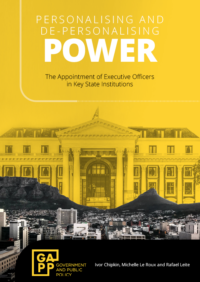The paradox of local government: Sacrificing service delivery at the altar of equity
Auditor-General Kimi Makwetu’s last report before he died identified a few municipalities whose accounts tell a ‘good story of disciplined spending that achieves value for money’. Yet these cases are overshadowed by a general tale of regression, indicating that the model of post-apartheid local government has failed.
This November 25 and 26, I participated in a conference on 25 Years of Local Government. The topic sounds dry. However, there was nothing dry about it. The event was organised by the think-tank that I run, GAPP, and the South African Local Government Association (Salga). It brought together many of the people who 25 years ago helped design the current model of local government. (The conference videos can be seen here.)
The “system architects” came together over two days to discuss the system that they had designed and to reflect on how it had fared over two and a half decades. This is what made the event so special.
At one level it was a mea culpa and on another it was a celebration. And therein lies an unrelenting tension. Were we honouring achievements accrued over 25 years, or lamenting a catastrophe? Local governments are widely deemed to have failed spectacularly. Typically, they are seen as sites of craven corruption, ineptitude and incompetence.
Municipalities fail to deliver basic services or maintain even the most basic infrastructure. Typically, on the very day of the conference itself, one commentator described Johannesburg in an article in Business Day as a city in terminal decline: “There is hardly a road in Joburg that is not crumbling, potholed or choked with weeds.”
The recent Auditor-General’s report on municipalities suggests that these remarks are neither anecdotal, nor about the city itself, nor about municipalities in general. Kimi Makwetu’s last report before he died identified a few municipalities whose accounts tell a “good story of disciplined spending that achieves value for money”. Most of them were in the Western Cape.
Yet these cases were overshadowed by a general tale of regression.
Against this background, it seems fairly obvious that the model of post-apartheid local government has failed. The current system is too generic, imposing “wall-to-wall” municipalities across the country, all cookie cut-outs of each other.
Some argued that large metros shouldn’t be treated as local governments at all, and be given an independent status in national political forums. After all, it was ridiculous to have the needs of the large cities, also the economic engines of the country, subsumed with those of other municipalities or, more seriously, overshadowed by provincial governments.
The South African Constitution formally provides an intergovernmental system composed of strong national government, weak provincial governments and strong municipalities – a Strong-Weak-Strong, or S-W-S model, if you like. This was the model that the ANC won in constitutional negotiations against federalists in other parties.
Ironically, as Philip van Ryneveld pointed out, the effects of this formal arrangement have been undone by the provincialisation of power in the ANC itself. The power of provincial and regional barons in ANC conferences has elevated the de facto authority of this sphere of government, especially against municipalities and metros that have no special standing in the ANC’s internal procedures.
In practice, therefore, South Africa has an S-S-W model of government. It has come at a very high price to the autonomy of municipalities, which are frequently embroiled in the internecine factionalism which has characterised ANC politics since 2007.
So when Yunus Carrim, the former deputy minister of Cooperative Governance and Cooperative Affairs, called the 1995 White Paper on Local Government “excellent”, and insisted that “I find it very hard to believe that we got the model wrong”, it provoked incredulity.
Michael Sachs, for one, jumped in to insist that the model had created the current crisis. But what Carrim and others who defended the model were effectively saying was that policymakers in the early 1990s couldn’t be blamed for not anticipating how the ANC would develop.
As a model, the emphasis on local autonomy, self-financing and participatory democracy was the right one. The model was betrayed by the poor calibre of people who were sent to populate the structures. This suggests that the current model can be saved if South Africa invests in finding better ways of recruiting, deploying and electing municipal officials and/or councillors.
If only it were that simple. What Sachs called out was the glibness of the 1994 generation.
The great value of a historical perspective on events, however, is that it is not simply a view from the present on the past. It is a view from the present in relation to the past. This is the difference between monitoring and evaluation and history. The first assumes a basic continuity between the intentions of the past and the intentions of the present. The second approach does not. And in the space opened up by a historical view another judgement on the model of local government becomes possible.
The local government model was designed fundamentally to overcome a history of apartheid racism, segregation, division, inequality and inequity in the representation of citizens, in the allocation of resources and in the organisation of space. Models of metropolitan government (unicities, metros with substructures), one- or two-tiered local governments, and district models were designed with this imperative primarily in mind. In this regard, they have frequently been successful.
Yet these designs did not adequately pay attention to the functional roles that municipalities must play in providing services and even in fostering economic growth. Local governments are not well designed to play their technical roles, that is. Most notably they conflate administrative and political roles. If in national and provincial governments the autonomy of officials and politicians is respected in the breach, in municipalities the distinction hardly exists.
From this perspective, Carrim and Sachs can both be right. We are in the midst, that is, less of a contradiction than of a paradox. The model has been successful in fostering equity. It is in crisis in terms of service delivery.
One of the symptoms of the malaise in South Africa is evident in the country’s public culture. There is a tendency towards simplification, as if the great complexity of our society and our history can be summed up in simple binaries: good/bad; corrupt/uncorrupt(able); success/failure. Proper policymaking has been replaced by sloganeering, whether it comes from political parties, civil society or the media.
Like the economic crisis, it is a sign of the intellectual crisis in South Africa too. The 25 Years of Local Government event represented a brief relief from this despondency and a glimpse of the public culture that South Africa needs.



